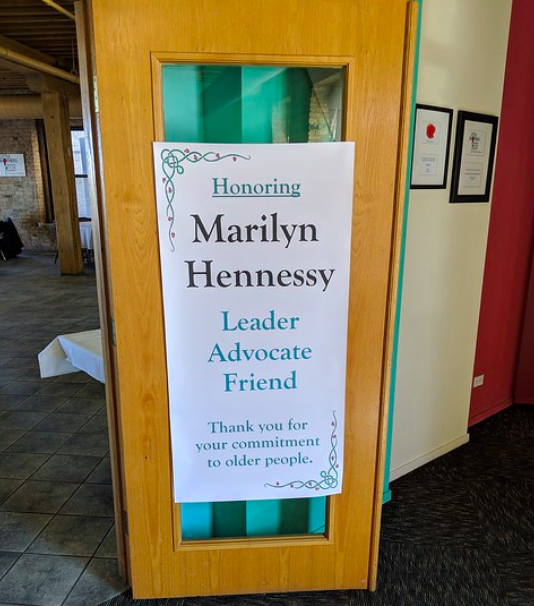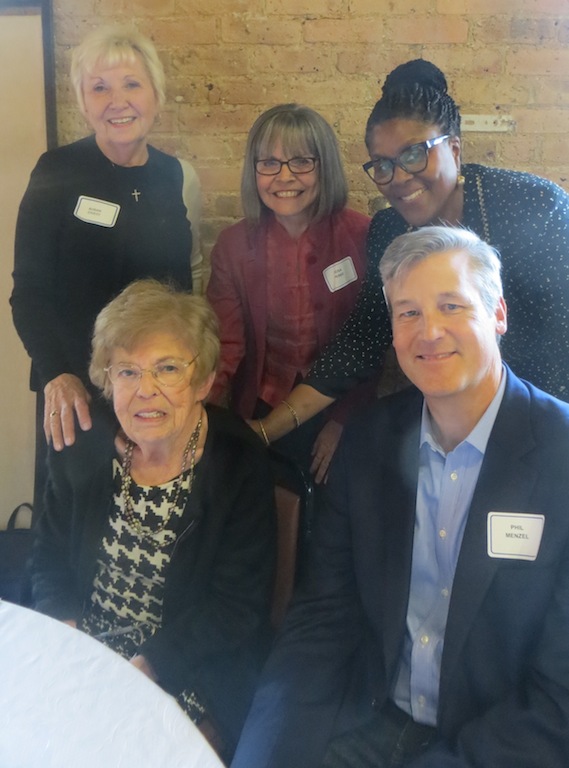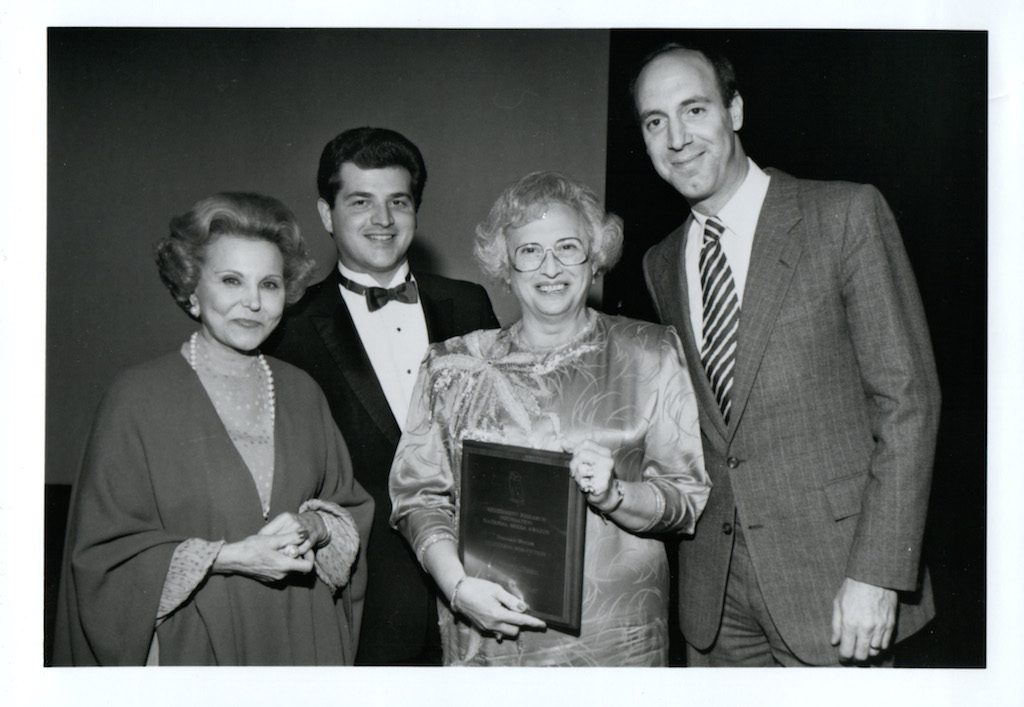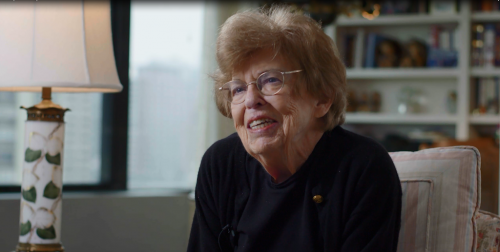
BY JUDY CARMACK BROSS
It was definitely a cause for celebration, and the guest list might have swelled to over several million people, all wanting to pay tribute to Marilyn Hennessy on her retirement recently as trustee of The Retirement Research Foundation. Before serving as trustee, Hennessy was the founding executive director, then president and CEO, of RRF since its inception.

Marilyn Hennessy.
As leader of the first foundation devoted exclusively to improving the quality of life for older people across the country, Hennessy finally succeeded in retiring but not without parties, proclamations, and praise for being a tireless advocate and much, much more.

From Hennessy’s retirement celebration.

Cheering on the honoree.
Irene Frye, current RRF president, told guests at a recent party in Marilyn’s honor: “Over a span of more than four decades, few others have so positively and consistently influenced the field of aging—from direct service providers to advocates to researchers. Always the risk taker but soft-spoken, modest, and humble, Marilyn chooses her words wisely. People felt the power of these words, and the passion and compassion behind them—they listened and were moved to action.”
A pioneer in recognizing issues affecting older women, particularly those widowed or divorced, Marilyn pointed out that they not only needed services but advocates as well.
Karen Ferguson, Pension Rights Center’s founder, said recently of Marilyn’s devotion to economic security: “One of RRF’s first grants went to our center. As a direct result of this and other grants, pension protection laws were passed, regulations adopted, cases won, and a federally funded pension counseling program, online referral service and a pro bono lawyers network were established.”
We sat down with Hennessy and asked about some of the programs that meant the most to her. One of the most significant successes involved advocating for ethnic elders in the greater Chicago area and bringing together many small organizations into a coalition, now numbering more than 40 groups, to help older people who are non-English speaking.
“When I first got involved, the whole focus on aging was just getting started. There were just not as many elders, and they were frailer, much different from our current population today,” Hennessy explains. “We recognized that our first focus had to be helping people maintain their independence and insuring their access to services.”
We asked Hennessy, who thrives on visits with her nieces and nephews, what some practical tips are for seniors today: “You have to maintain friendships and connections—keep in touch with people even if you can’t see them in person. Many people are starting whole new careers. There are so many positives out there.”
What did she like most about her job? “I have always liked people and in my job the best part was hearing lots of good ideas, and then responding to opportunities.”
Naomi Stanhaus, longtime RRF program consultant, told us a little of the foundation’s history: “One of two MacArthur Foundations founded in Chicago, RRF was incorporated in 1950 by John D. MacArthur and was endowed at the time of his death in 1978. The foundation has always held fast to is its mission to improve the quality of life for older people in the U.S.”
Since 1979 the RRF has awarded more than $225 million to support projects that enhance and improve the quality of life for older people, with nearly half of its grants supporting programs in the Midwest. The foundation also supports innovative solutions that assist older Americans nationwide.
Stanhaus explained, “We are a funding organization and as such we listen to, and encourage, good ideas. Marilyn’s approachable nature and her non-judgmental manner worked so well with the people who received funding, everyone benefitted from her generosity of spirit, vision, and follow through.”

Hennessy with Susan Ciucci, Rosa Perez, Simone Mitchell-Peterson, and Phil Menzel, all of Little Brothers – Friends of the Elderly, Chicago.
Hennessy has shared her vision far and wide. She was an active participant in the White House Conferences on Aging and consulted on aging issues in China and at other places around the world. She was one of the founders of Grantmakers in Aging, a national network of funders that support aging services and issues.
Frye provided many examples of the pioneering work that Hennessy encouraged the foundation to support. Hospital-related delirium is just one of them. More than 2.5 million older people suffer from delirium, an acute decline in cognitive functioning and attention that may be a complication of hospitalization. Decades ago, a pioneer doctor and researcher, Sharon Inouye, recognized the need for a delirium intervention, approaching Hennessy to request support for her research that led to the development of the Hospital Elder Life Program (HELP). HELP is an effective screening and delirium treatment model that also reduces the high costs of hospitalization and long-term care. Without Hennessy’s encouragement and support, HELP may never have occurred. This program is now used by hundreds of hospitals, not only in the U.S. but around the world.
Today, there is more widespread discussion of ageism and a movement to change the language to more positively reflect momentum, rather than a decline, in aging. But, well before that, Frye explained, Hennessy recognized that older people needed to be depicted more realistically. She created the Foundation’s OWL awards to recognize people in the film industry who portrayed aging in more sensitive ways. Rita Moreno, one of only a few EGOTs (Emmy, Grammy, Oscar, and Tony award-winners), was the first OWL recipient. The OWL awards grew in stature, thanks in part to luminaries like Helen Hayes, Ann Landers, and film critic Gene Siskel, who served as emcees at the OWL awards ceremonies.

Hennessy at the OWL Media Awards, circa 1987.

From the OWL Media Awards.
Ruth Ann Watkins, Chair of the RRF Board of Trustees, wrote to Marilyn at her retirement:
You are intelligent, savvy, strong, dignified, and a truly caring leader. You are also so modest that I’m not sure you acknowledge the enormous impact of what you have had as president of RRF and also as you have lived your life, dedicated to making life better for the most vulnerable, not only of older people but also of immigrants, and colleagues, and for helping people to be their best. You are held in such high esteem and affection by your RRF family and by the field of aging.
She concluded her letter by saying, “We, and people who will never know who you are, live a better life because of what you have made possible through RRF, what it has done, what it is today and promises to be.”
For more information about The Retirement Research Foundation, visit rrf.org.






